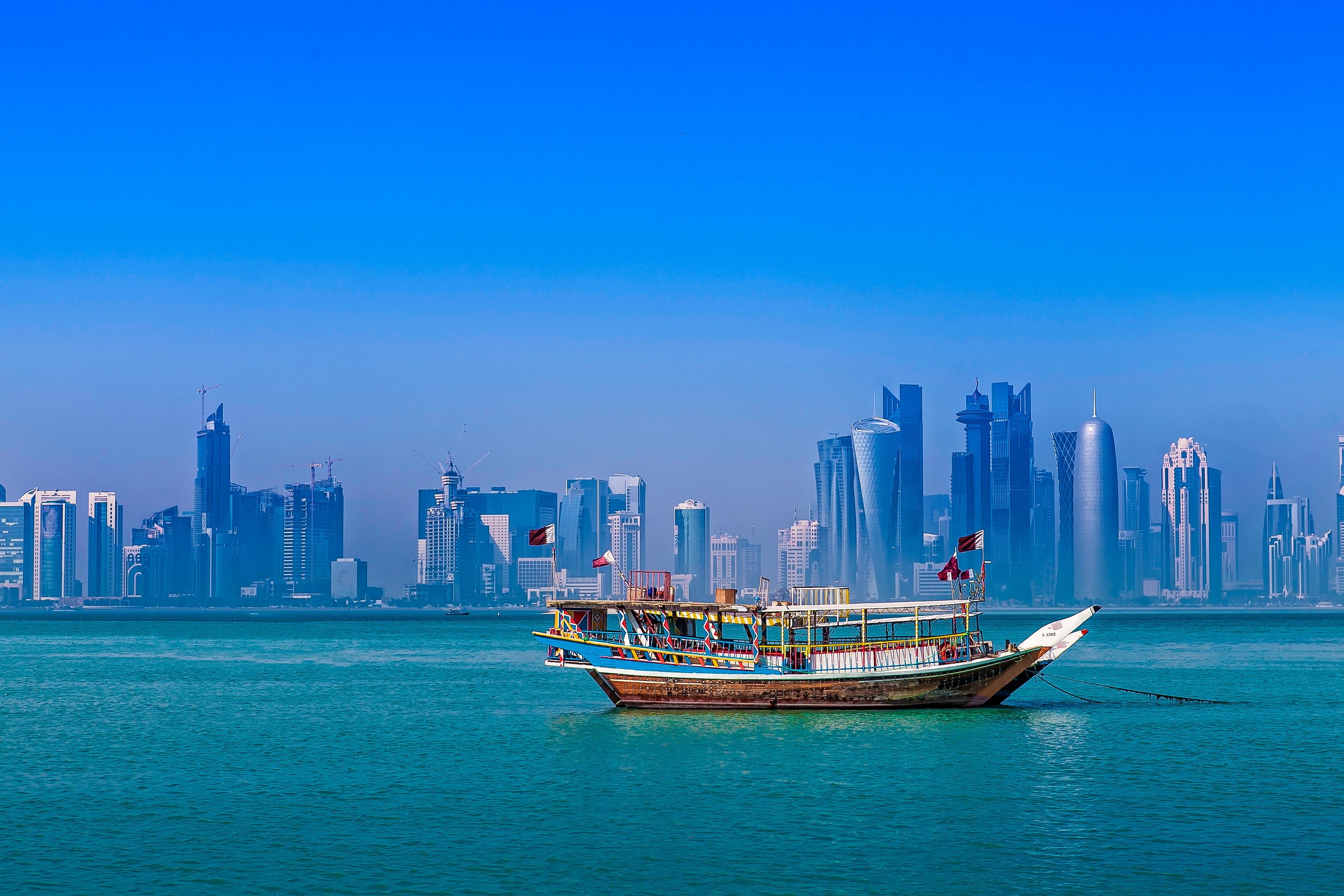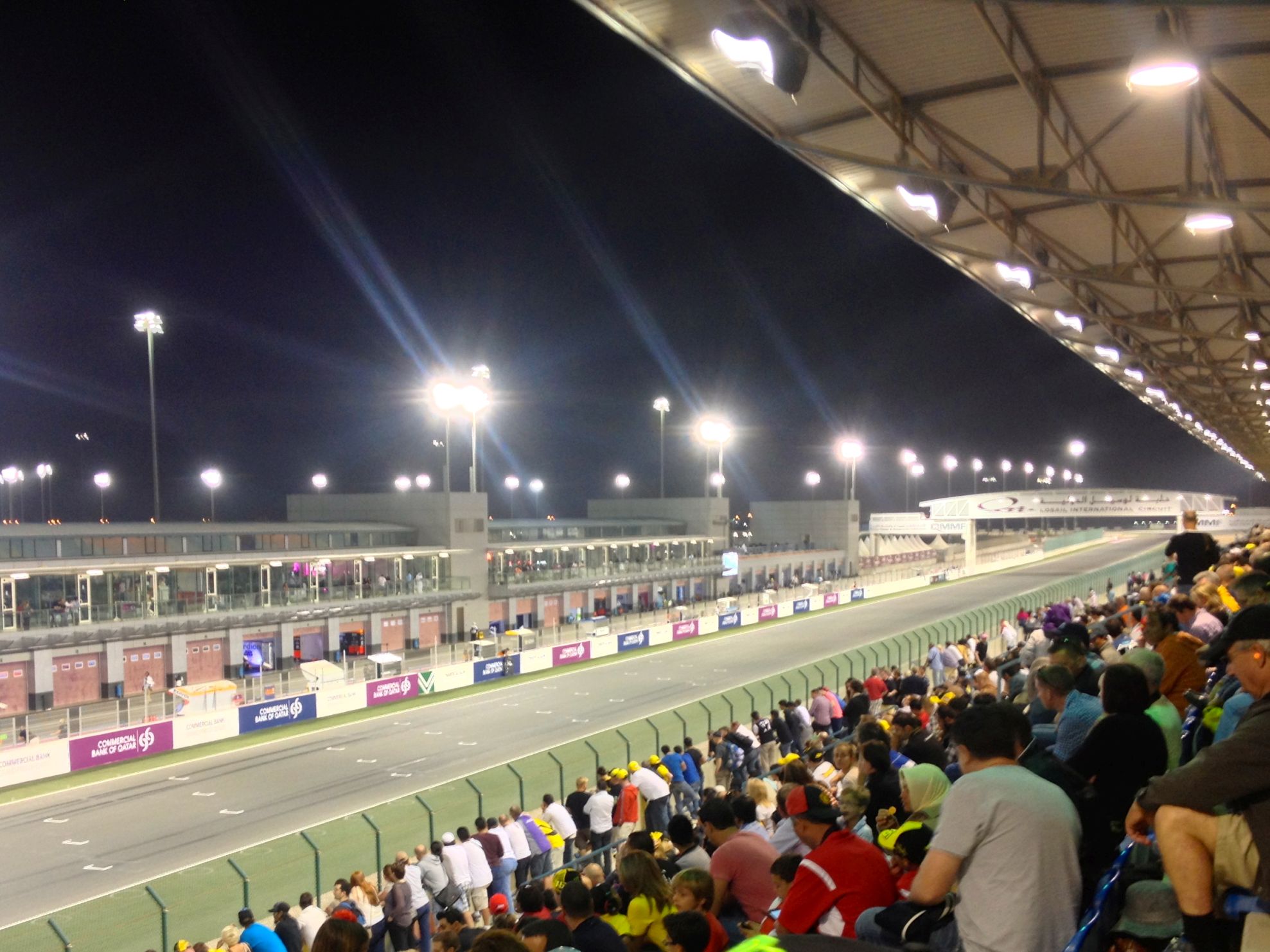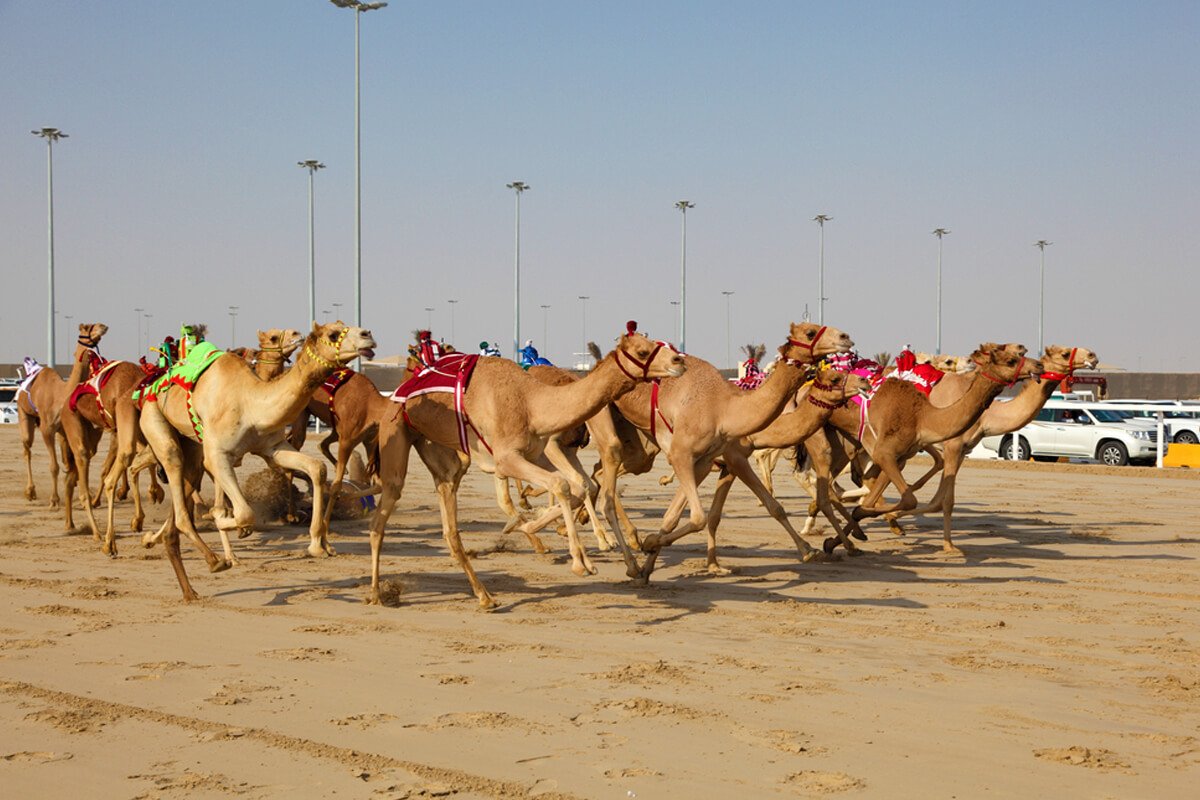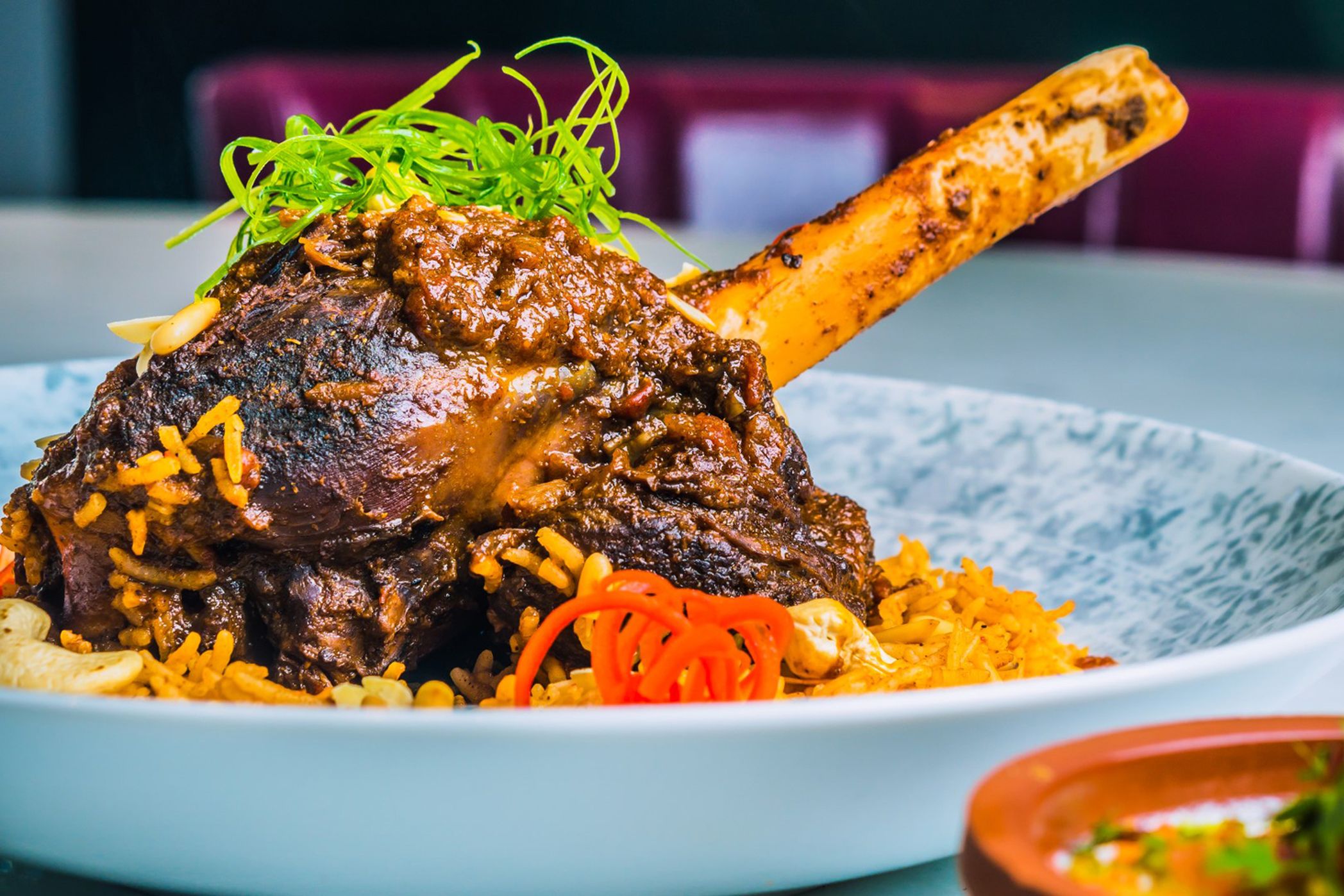
As a quick hit to recharge when travelling to or from Europe, Doha makes for an eye-opening stopover in the heart of the Middle East. The capital of Qatar pulses with all the flamboyant bling of Dubai, overlaid with deep pockets of old world Doha, where tradition, heritage and culture abound. Doha seems to have nailed the sense of urban intermingling – the fusion of cutting-edge modernity and traditional vibes.
My favourite quintessential experience is to savour golden hour aboard a traditional Dhow cruise on Doha Bay, as the slumping sun gilds the skyline. Pearl diving was the mainstay of the Qatari economy right up until the 1930s when Japan pioneered cultured pearls and revolutionised the lucrative pearl trade. Dhow boats were traditionally used by pearl divers, so a leisurely float aboard one of these wooden cuties provides a tangible link with the past.
 Dhow and the West Bay skyline. Photo / Supplied
Dhow and the West Bay skyline. Photo / Supplied
When you’ve had your fill of gazing at West Bay’s futuristic skyline, studded with so many edgy designs and distinctive buildings, there’s plenty more starchitecture to explore on-foot. I’m a self-confessed building nerd and Doha’s rollcall of boundary-busting architects who have left their calling card here is formidable. I M Pei, Norman Foster, and Jean Nouvel lead the line-up.
Step out on the 7km-long horseshoe-shaped Corniche promenade, that connects old Doha with West Bay. It’s an impeccably landscaped waterfront playground, packed with cutting-edge public amenities like open-air gym equipment and phone-charging stations. Like so many public spaces in Doha, outdoor air-conditioning is becoming the norm, with highly effective cooling vents taming the desert heat in highly trafficked places.
In a city of stacked with museums, you really are spoilt for choice. But if you have time only for one, my suggestion would be the Museum of Islamic Art. It’s a chiselled jewel, designed by I M Pei, of Louvre glass pavilion fame. The museum has an illusory quality of floating on the water. Pei was determined to encapsulate the essence of Islamic architecture in his design. The building’s bright white cubes reflect in the sea by day and are illuminated by night. The curved openings in the top tower resemble the eye slit of a burqa while the museum’s ceiling is a traditional geometric pattern. Calligraphy, Islamic patterns, jewellery and textiles from three continents comprise its vast collection. Reaching back 1400 years, the museum charts the artistic flowering of Islam. The biggest unmissable is the necklace that once belonged to Shah Jahan, builder of India's Taj Mahal, studded with huge diamonds and emeralds. The British didn’t get their hands on that one.
 Museum of Islamic Art and West Bay lights. Photo / Supplied
Museum of Islamic Art and West Bay lights. Photo / Supplied
Twenty minutes north of downtown Doha, I headed by metro to Lusail, home to the gleaming stadium that is nicknamed the Lantern. It was here that Lionel Messi raised the FIFA World Cup in 2022. Qatar continues to cultivate its credentials as a superhost for global sport occasions – and surely it’s only a matter of time before they bag the Olympic Games, unless Saudi Arabia beats them to the punch. Lusail is Qatar’s newest and second-largest city. There’s serious starchitecture here too, like the crescent-shaped Katara Towers with the country’s first six-star hotel; the Marina Twin Towers, which look like giant Lego blocks; and the French-inspired Place Vendôme Mall. Lusail is also a byword for vroom-vroom!
The F1 Qatar Grand Prix is just a fortnight away from being held. The purpose-built racetrack, known as the Lusail International Circuit, is highly regarded by F1 fans, particularly for its 1km long main straight, which throws up plenty of high-octane thrills. But when the big boys are not in town, you can score some track-time on the circuit, whether you want to run, cycle, skate, walk – or best of all, ride the souped-up go-karts. Channel you inner Lando Norris and hit the tarmac.
 Lusail International Circuit. Photo / Supplied
Lusail International Circuit. Photo / Supplied
Speaking of racing, for something more traditional from Qatari culture, why not pay a visit to Al Shahaniya racetrack for camel-racing? Held every Friday from October to February, it’s a wild experience and highly competitive. Originally, children would be used as jockeys for the camels, but robots have been used instead since 2004 for health and safety reasons. The robots are controlled remotely by the camel herders who often drive alongside the track. How’s that for the complete combo of old and new?
If you want more camel time or to try riding one of these graceful ships of the desert, camel riding is on offer in the heart of old Doha at the sublime Souq Waqif. As are Arabian horses. The atmospheric marketplace is also home to the falcon souq. Not only can you buy a falcon here, but it’s also go-to for falcon accessories such as landing pads and GPS guidance systems for the birds. They even have an on-site falcon hospital. I was quite taken aback to see two lovely old men carrying their sick falcon through the arrivals hall at Hamad International Airport.
 Camel racing in Doha. Photo / Supplied
Camel racing in Doha. Photo / Supplied
Beyond the wildlife, Souq Waqif is a bustling blend of sights, sounds, and scents that captures the heart of Qatar's rich culture. It’s a sprawling, atmospheric stone complex of restored buildings, riddled with winding alleys, bursting with spice stalls, perfumeries, handcrafted goods, outstanding dining venues and superb local art. For a great keepsake, pop into the Souq Waqif Art Centre, to see one of the resident artists at work and peruse their traditional Arabic design pieces.
One of the most iconic breakfast spots in Doha, Shay Al Shomoos, is located at Souq Waqif’s airconditioned walkway. The restaurant is run by Shams Al Qassabi, who was the first woman to establish a business in Souq Waqif. One of the most popular items at this the breakfast spot is the traditional dish, regag.
But if there’s one signature dish you have to try during a visit to Qatar, it’s undoubtedly machboos. The dish, made of rice, meat, onions and tomatoes, mixed with spices, is the national dish of Qatar. Most importantly, it’s incredibly delicious.
 Lamb shank Machboos. Photo / Time Out
Lamb shank Machboos. Photo / Time Out
Destination dining? Snag a booking at Parisa. This gorgeous Persian restaurant in Souq Waqif has mosaics along the walls, ornate chandeliers, and a mirrored ceiling that took three-and-a-half years to finish. On the food front, signature dishes include watermelon salad, kashko bademjan and lamb kebab. Delicious.
Qatar Airways has every reason to feel on top of the world. The multiple award-winning airline has been crowned the 2025 World’s Best Airline by Skytrax, scooping the supreme honours for the ninth consecutive year. Qatar Airways flies non-stop between Doha and Auckland daily, one of the world’s heroic ultra-long-haul flights, currently ranked third longest in the world. Kiwis enjoy visa-free entry into Doha. Experience an unrivalled standard of Business Class in your very own personal suite with privacy doors. QSuite is available on the daily Auckland service, delivering first-class luxury to the Business Class cabin, including double lie-flat beds. I flew in Economy, and you’ll notice the difference with one of the widest seats in the industry, complete with adjustable headrests. With the generous seat recline, I had no trouble stretching my legs completely out in front of me, with unobstructed access under the seat in front of you. Beyond Doha, Qatar Airways flies to over 170 destinations worldwide. qatarairways.com
Mike Yardley is our resident traveller on Jack Tame Saturday Mornings.
Take your Radio, Podcasts and Music with you









